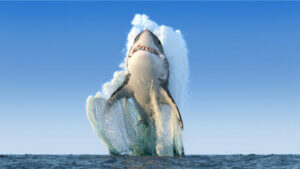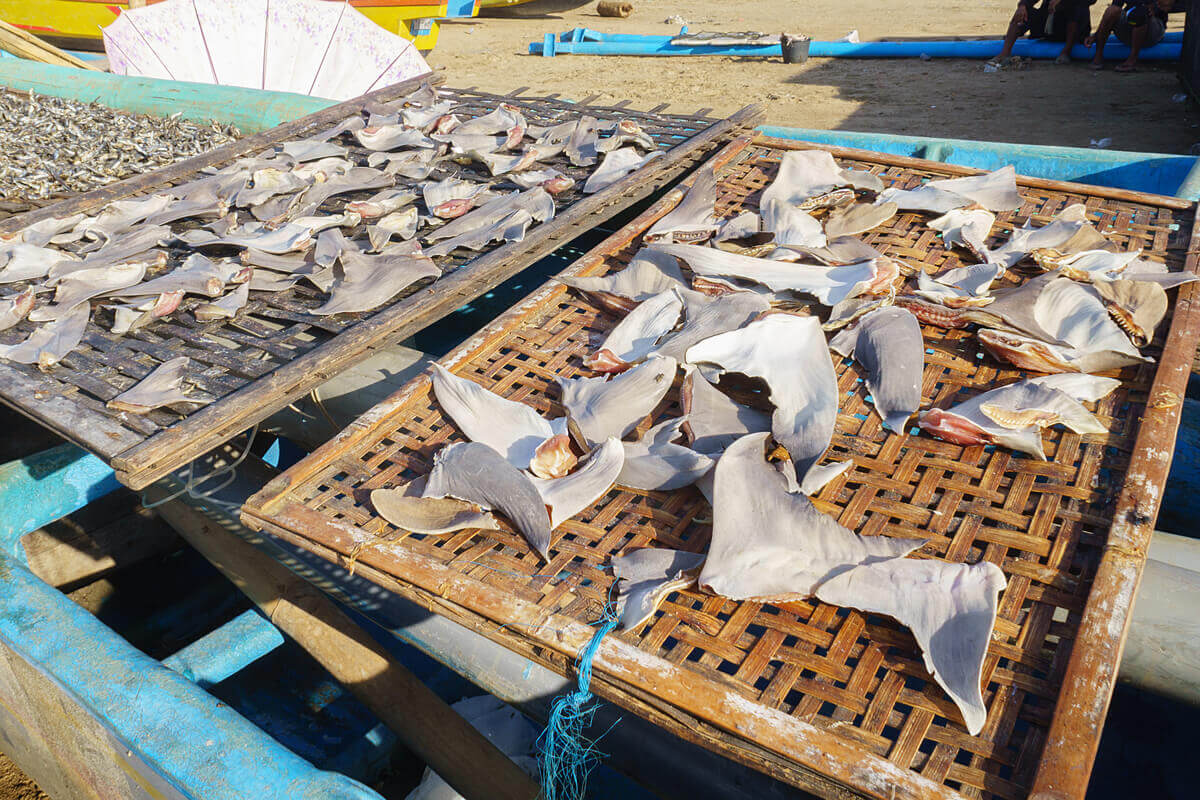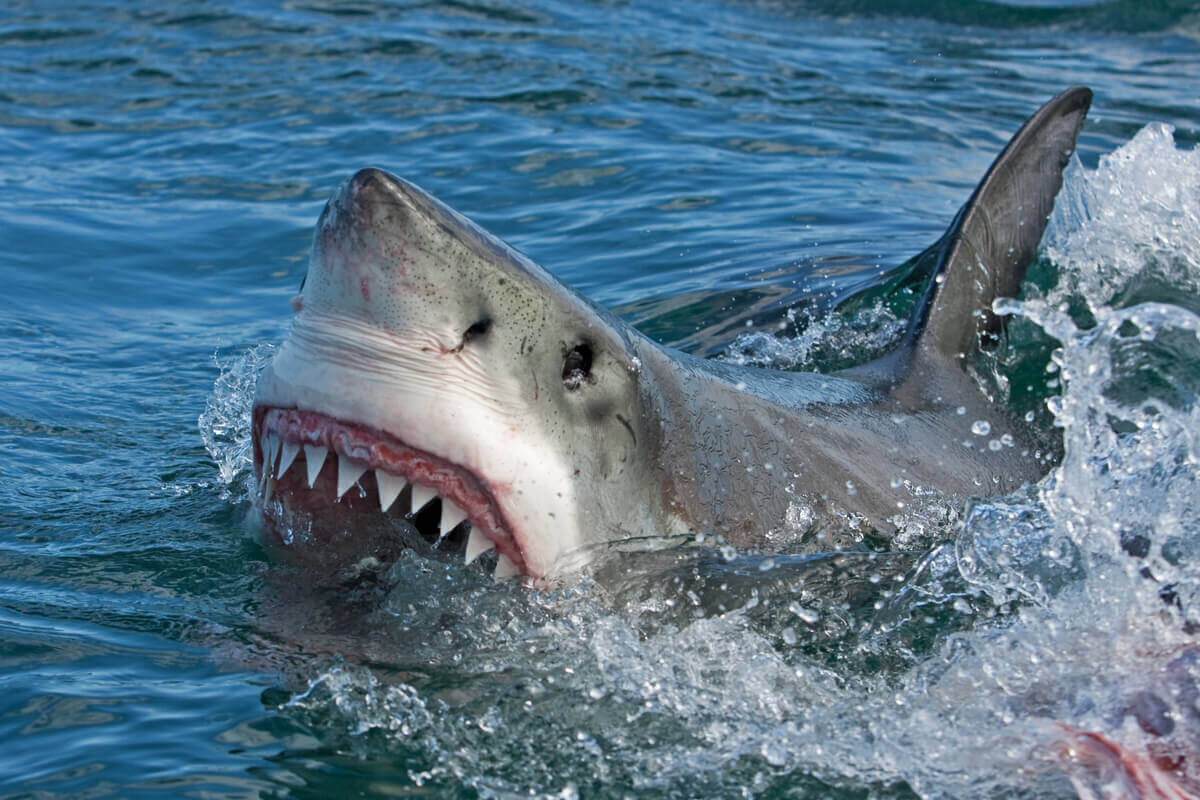Is it True that Sharks Don't Get Sick?


Written and verified by biochemistry Luz Eduviges Thomas-Romero
There are many reasons why people are fascinated by sharks. However, not everything people tend to believe about these animals is true. For example, many think that sharks don’t get sick, but that’s just not the case. In order to better understand and appreciate the marine giants, we need to take a closer look at their biology.
First of all, did you know that sharks have been around since long before the time of dinosaurs? In fact, the registry of their evaluation goes back some 450 million years. Therefore, these creatures possess adaptations that have allowed them to survive where many other creatures couldn’t.
One of the most striking characteristics, which they share with their relatives the stingrays, is that they have no bones. Their skeletons consist completely of cartilage. What’s more, they can produce more than 30,000 teeth over the course of their lives. So, when one tooth falls out, another tooth from one of the back rows takes its place.
It’s a myth that sharks don’t get sick
The myth that sharks don’t get sick is something we often run across on social media. It’s common to read that these are the only animals that don’t get sick, or that they’re even immune to common diseases like cancer.
At the beginning of the 1990s, a non-scientific book became famous, claiming that shark cartilage could save cancer patients. While the document didn’t claim that sharks are immune to cancer, it did argue that it’s uncommon for them to have solid tumors.
The supposed miraculous properties of shark cartilage regarding cancer
First of all, in order to understand these arguments, we first need to understand the concept of angiogenesis. This word refers to the process through which new blood cells develop out of the already present vasculature. So, angiogenesis is the formation of new capillaries in different tissues.
At the same time, it’s common for angiogenesis to occur in many types of tumors and has to do with tumoral growth. What’s more, cartilage doesn’t possess blood vessels. In other words, it’s avascular.
Very rarely do we see the development of malignant tumors that involve cartilage. Therefore, the market for alternative products considers cartilage a source of antiangiogenic compounds.

Science refutes the myth that sharks don’t get sick
Contrary to popular belief, it’s an unquestionable fact that sharks suffer from all sorts of illnesses. Without a doubt, scientific reports have registered cases of cancer in sharks, and even chondromas (cartilage cancers).
To date, experts have documented tumors in at least 23 different shark species. And reports of cases may go up as research regarding cancer in these animals increases.
Shark cartilage doesn’t work as a cancer treatment
It’s also interesting to look at the research regarding Neovastat, a compound extracted from shark cartilage. Scientists evaluated its combination with chemotherapy in a clinical trial in phase III lung cancer patients. However, after more than 6 years of follow-up, they closed the trial due to a lack of therapeutic effectiveness.
The same occurred in a clinical trial involving patients in phase II of renal cell carcinoma and other trials involving patients with breast cancer and colon cancer.
There was no improvement in overall survival in any of these studies. Just the same, the market is still trying to associate shark cartilage with the treatment of illnesses like psoriasis.
No study has managed to demonstrate that shark cartilage is an effective treatment. Nevertheless, the demand for cartilage has managed to decimate the world’s shark population.
The importance of sharks in the marine ecosystem
According to a 2013 study, human beings kill some 100 million sharks per year. The overfishing of sharks has to do with the demands for their meat, liver oil, cartilage, and their valuable fins. Often, fishers will cut the fins off of live sharks and use it for shark fin soup, and ancient and expensive Asian delicacy.
It’s important to point out that the loss of shark populations is a reason for concern. As apex predators, they help balance the ecosystem in our world’s oceans. If there aren’t enough predators, then there’ll be a series of changes in the ecosystem that will even affect marina plants.
Organizations like the Convention on International Trade in Endangered Species of Wild Fauna and Flora (CITES) progressively add to the list of shark species with commercial protection. However, these initiatives may take time to arrive.
La reproduction of sharks is varied and complex
Depending on the particular species, sharks reproduce three different ways:
- Oviparity: They lay eggs and deposit them in a safe place for incubation.
- Viviparity: Sharks are born live, directly.
- Ovoviviparity: Sharks carry their young in egg sacks that enclose in their uterus. The young sharks develop inside their mothers and are born live. This is a combination of the first two strategies.
What’s more, the duration of gestation varies according to each species, as does litter size. In fact, the number of young a mother shark can give birth to ranges from two (viviparity) to 100 (oviparity). The main consequence of very long gestation periods is that vulnerable shark species take a long time to regain their numbers.
Given that sharks have slow reproduction rates and development, it can be hard for populations to recover from great losses.

Conservation and knowledge
Society is a machine that can dictate patient behavior patterns, the type of treatment they seek, and what they decide. Therefore, it’s important to ponder the fact that false beliefs among society create insuperable obstacles.
It’s crucial that we remember that most of the information on the internet and printed media is not regulated. Therefore, it can contain extreme viewpoints that make current problems even worse. That being said, the commerce of materials that come from sharks to combat cancer is a clear example of human ignorance.
There are many reasons why people are fascinated by sharks. However, not everything people tend to believe about these animals is true. For example, many think that sharks don’t get sick, but that’s just not the case. In order to better understand and appreciate the marine giants, we need to take a closer look at their biology.
First of all, did you know that sharks have been around since long before the time of dinosaurs? In fact, the registry of their evaluation goes back some 450 million years. Therefore, these creatures possess adaptations that have allowed them to survive where many other creatures couldn’t.
One of the most striking characteristics, which they share with their relatives the stingrays, is that they have no bones. Their skeletons consist completely of cartilage. What’s more, they can produce more than 30,000 teeth over the course of their lives. So, when one tooth falls out, another tooth from one of the back rows takes its place.
It’s a myth that sharks don’t get sick
The myth that sharks don’t get sick is something we often run across on social media. It’s common to read that these are the only animals that don’t get sick, or that they’re even immune to common diseases like cancer.
At the beginning of the 1990s, a non-scientific book became famous, claiming that shark cartilage could save cancer patients. While the document didn’t claim that sharks are immune to cancer, it did argue that it’s uncommon for them to have solid tumors.
The supposed miraculous properties of shark cartilage regarding cancer
First of all, in order to understand these arguments, we first need to understand the concept of angiogenesis. This word refers to the process through which new blood cells develop out of the already present vasculature. So, angiogenesis is the formation of new capillaries in different tissues.
At the same time, it’s common for angiogenesis to occur in many types of tumors and has to do with tumoral growth. What’s more, cartilage doesn’t possess blood vessels. In other words, it’s avascular.
Very rarely do we see the development of malignant tumors that involve cartilage. Therefore, the market for alternative products considers cartilage a source of antiangiogenic compounds.

Science refutes the myth that sharks don’t get sick
Contrary to popular belief, it’s an unquestionable fact that sharks suffer from all sorts of illnesses. Without a doubt, scientific reports have registered cases of cancer in sharks, and even chondromas (cartilage cancers).
To date, experts have documented tumors in at least 23 different shark species. And reports of cases may go up as research regarding cancer in these animals increases.
Shark cartilage doesn’t work as a cancer treatment
It’s also interesting to look at the research regarding Neovastat, a compound extracted from shark cartilage. Scientists evaluated its combination with chemotherapy in a clinical trial in phase III lung cancer patients. However, after more than 6 years of follow-up, they closed the trial due to a lack of therapeutic effectiveness.
The same occurred in a clinical trial involving patients in phase II of renal cell carcinoma and other trials involving patients with breast cancer and colon cancer.
There was no improvement in overall survival in any of these studies. Just the same, the market is still trying to associate shark cartilage with the treatment of illnesses like psoriasis.
No study has managed to demonstrate that shark cartilage is an effective treatment. Nevertheless, the demand for cartilage has managed to decimate the world’s shark population.
The importance of sharks in the marine ecosystem
According to a 2013 study, human beings kill some 100 million sharks per year. The overfishing of sharks has to do with the demands for their meat, liver oil, cartilage, and their valuable fins. Often, fishers will cut the fins off of live sharks and use it for shark fin soup, and ancient and expensive Asian delicacy.
It’s important to point out that the loss of shark populations is a reason for concern. As apex predators, they help balance the ecosystem in our world’s oceans. If there aren’t enough predators, then there’ll be a series of changes in the ecosystem that will even affect marina plants.
Organizations like the Convention on International Trade in Endangered Species of Wild Fauna and Flora (CITES) progressively add to the list of shark species with commercial protection. However, these initiatives may take time to arrive.
La reproduction of sharks is varied and complex
Depending on the particular species, sharks reproduce three different ways:
- Oviparity: They lay eggs and deposit them in a safe place for incubation.
- Viviparity: Sharks are born live, directly.
- Ovoviviparity: Sharks carry their young in egg sacks that enclose in their uterus. The young sharks develop inside their mothers and are born live. This is a combination of the first two strategies.
What’s more, the duration of gestation varies according to each species, as does litter size. In fact, the number of young a mother shark can give birth to ranges from two (viviparity) to 100 (oviparity). The main consequence of very long gestation periods is that vulnerable shark species take a long time to regain their numbers.
Given that sharks have slow reproduction rates and development, it can be hard for populations to recover from great losses.

Conservation and knowledge
Society is a machine that can dictate patient behavior patterns, the type of treatment they seek, and what they decide. Therefore, it’s important to ponder the fact that false beliefs among society create insuperable obstacles.
It’s crucial that we remember that most of the information on the internet and printed media is not regulated. Therefore, it can contain extreme viewpoints that make current problems even worse. That being said, the commerce of materials that come from sharks to combat cancer is a clear example of human ignorance.
All cited sources were thoroughly reviewed by our team to ensure their quality, reliability, currency, and validity. The bibliography of this article was considered reliable and of academic or scientific accuracy.
- Ostrander, G. K., Cheng, K. C., Wolf, J. C., & Wolfe, M. J. (2004). Shark cartilage, cancer and the growing threat of pseudoscience. Cancer research, 64(23), 8485-8491. https://cancerres.aacrjournals.org/content/64/23/8485
- Mehta, P., Bhajoni, P., & Mehta, S. (2016). Fighting cancer through an informed society. Journal of Social Health and Diabetes, 4(2), 57-66. https://d-nb.info/1183549881/34
- Borucinska, J. D., Schmidt, B., Tolisano, J., & Woodward, D. (2008). Molecular markers of cancer in cartilaginous fish: immunocytochemical study of PCNA, p‐53, myc and ras expression in neoplastic and hyperplastic tissues from free ranging blue sharks, Prionace glauca (L.). Journal of fish diseases, 31(2), 107-115.
- Robbins, R., Bruce, B., & Fox, A. (2014). First reports of proliferative lesions in the great white shark, Carcharodon carcharias L., and bronze whaler shark, Carcharhinus brachyurus Günther. Journal of fish diseases, 37(11), 997-1000. https://onlinelibrary.wiley.com/doi/abs/10.1111/jfd.12203
- Ernst, E. (2006). Why there will never be an alternative cancer cure. Anti-cancer drugs, 17(9), 1023-1024. https://journals.lww.com/anti-cancerdrugs/Citation/2006/10000/Why_there_will_never_be_an_alternative_cancer_cure.3.aspx
- Criscitiello, M. F. (2014). What the shark immune system can and cannot provide for the expanding design landscape of immunotherapy. Expert opinion on drug discovery, 9(7), 725-739. https://www.tandfonline.com/doi/abs/10.1517/17460441.2014.920818
- Henningsen, A. D., Smale, M. A. L. C. O. L. M., Garner, R., & Kinnunen, N. I. N. O. (2004). Reproduction, embryonic development, and reproductive physiology of elasmobranchs. The elasmobranch husbandry manual: captive care of sharks, rays and their relatives. Biological Survey, Ohio, 227-236. http://www.academia.edu/download/54676898/Elasmobranch_Husbandry_Manual_1.pdf#page=235
- Borucinska, J. D., Harshbarger, J. C., & Bogicevic, T. (2003). Hepatic cholangiocarcinoma and testicular mesothelioma in a wild‐caught blue shark, Prionace glauca (L.). Journal of Fish Diseases, 26(1), 43-49.
- Lu, C., Lee, J. J., Komaki, R., Herbst, R. S., Feng, L., Evans, W. K., Choy, H., Desjardins, P., Esparaz, B. T., Truong, M. T., Saxman, S., Kelaghan, J., Bleyer, A., & Fisch, M. J. (2010). Chemoradiotherapy with or without AE-941 in stage III non-small cell lung cancer: a randomized phase III trial. Journal of the National Cancer Institute, 102(12), 859–865. https://doi.org/10.1093/jnci/djq179
- Batist, F. Patenaude, P. Champagne, D. Croteau, C. Levinton, C. Hariton, B. Escudier, E. Dupont (2002). Neovastat (AE-941) in refractory renal cell carcinoma patients: report of a phase II trial with two dose levels Ann. Oncol., 13 (8), pp. 1259-1263. https://europepmc.org/article/med/12181250
- Loprinzi CL, Levitt R, Barton DL, Sloan JA, Atherton PJ, Smith DJ et al. (2005). North Central Cancer Treatment Group. Evaluation of shark cartilage in patients with advanced cancer: a North Central Cancer Treatment Group trial. Cancer 104(1):176.
This text is provided for informational purposes only and does not replace consultation with a professional. If in doubt, consult your specialist.








